View in other NatureServe Network Field Guides
NatureServe
Montana
Utah
Wyoming
Idaho
Wisconsin
British Columbia
South Carolina
Yukon
California
New York
Plains Minnow - Hybognathus placitus
State Rank Reason (see State Rank above)
Species is widely distributed, may be undergoing minor declines and faces numerous low severity threats
General Description
The plains minnow is similar to the western silvery minnow in many features. It is native, silvery in color, found in the same major drainages and even at the same sites as the western silvery minnow, eats similar foods and attains about the same size. The plains minnow is so similar to the western silvery minnow that the two can only be told apart after making a dissection and examining a certain bone in the head.
Diagnostic Characteristics
Overall, the plains minnow is very silvery; the back is dusky or yellowish-olive, and the underside is white. The plains minnow has 15 to 22 scales across the belly from lateral line to lateral line.
Species Range
Montana Range
Range Descriptions
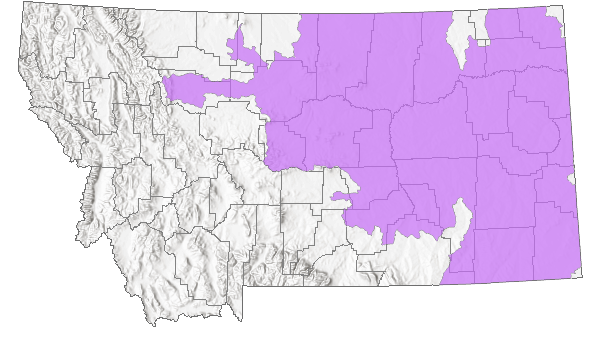
 Native
Native
Western Hemisphere Range

Range Comments
Native range includes the Missouri, Arkansas, Red, Brazos, and Colorado River drainages, from Montana and North Dakota south to New Mexico and Texas; Mississippi River from mouth of Missouri River to mouth of Ohio River. In Montana, this species is found east of the continental divide in streams of the Northern Prairies and Northwestern Great Plains Ecoregions.
Observations in Montana Natural Heritage Program Database
Number of Observations: 591
(Click on the following maps and charts to see full sized version)
Map Help and Descriptions
Relative Density
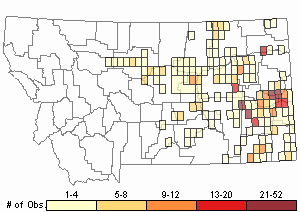
Recency
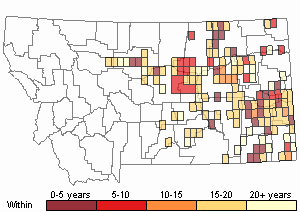
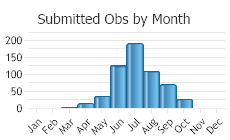
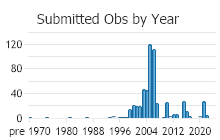
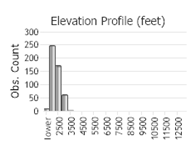 (Observations spanning multiple months or years are excluded from time charts)
(Observations spanning multiple months or years are excluded from time charts)
Habitat
Habitat for the plains minnow is probably similar to that for the western silvery minnow. Seventy percent of specimens in a southeast Montana study were taken in the mouths of streams, showing their preference for larger streams.
Food Habits
Food habits are probably very similar to the western silvery minnow.
Ecology
The ecology of the plains minnow is very similar to H. argyritis. They are distinguishable by the pharyngeal process of the basioccipital.
Reproductive Characteristics
Reproductive biology is probably very similar to the western silvery minnow.
Stewardship Responsibility
Threats or Limiting Factors
Threats to this minnow species is largely from introduced predatory fishes, such as northern pike and walleye.
References
- Literature Cited AboveLegend:
 View Online Publication
View Online Publication Lee, D.S., C.R. Gilbert, C.H. Hocutt, R.E. Jenkins, D. E. McAllister, J. R. Stauffer, Jr. 1980. Atlas of North American freshwater fishes. North Carolina State Musuem of Natural History. 867 p.
Lee, D.S., C.R. Gilbert, C.H. Hocutt, R.E. Jenkins, D. E. McAllister, J. R. Stauffer, Jr. 1980. Atlas of North American freshwater fishes. North Carolina State Musuem of Natural History. 867 p. Scott, W.B. and E.J. Crossman. 1973. Rainbow trout, Kamloops trout, Steelhead trout Salmo gairdneri Richardson. pp. 184-191. In: Freshwater fishes of Canada. Ottawa, Canada: Fisheries Research Board of Canada, Bulletin 184. 966 p.
Scott, W.B. and E.J. Crossman. 1973. Rainbow trout, Kamloops trout, Steelhead trout Salmo gairdneri Richardson. pp. 184-191. In: Freshwater fishes of Canada. Ottawa, Canada: Fisheries Research Board of Canada, Bulletin 184. 966 p.
- Additional ReferencesLegend:
 View Online Publication
View Online Publication
Do you know of a citation we're missing? Barfoot, C.A. 1993. Longitudinal distribution of fishes and habitat in Little Beaver Creek, Montana. M.Sc. Thesis. Bozeman, MT: Montana State University. 66 p.
Barfoot, C.A. 1993. Longitudinal distribution of fishes and habitat in Little Beaver Creek, Montana. M.Sc. Thesis. Bozeman, MT: Montana State University. 66 p. Clancey, C.G. 1978. The fish and aquatic invertebrates in Sarpy Creek, Montana. M.Sc. Thesis. Bozeman, MT: Montana State University. 54 p.
Clancey, C.G. 1978. The fish and aquatic invertebrates in Sarpy Creek, Montana. M.Sc. Thesis. Bozeman, MT: Montana State University. 54 p. Duncan, M.B. 2019. Distributions, abundances, and movements of small, nongame fishes in a large Great Plains river network. Ph.D. Dissertation. Bozeman, MT: Montana State University. 255 p.
Duncan, M.B. 2019. Distributions, abundances, and movements of small, nongame fishes in a large Great Plains river network. Ph.D. Dissertation. Bozeman, MT: Montana State University. 255 p. Joslin, Gayle, and Heidi B. Youmans. 1999. Effects of recreation on Rocky Mountain wildlife: a review for Montana. [Montana]: Montana Chapter of the Wildlife Society.
Joslin, Gayle, and Heidi B. Youmans. 1999. Effects of recreation on Rocky Mountain wildlife: a review for Montana. [Montana]: Montana Chapter of the Wildlife Society. Mullen, J.A. 2007. Spatiotemporal variation of fish assemblages in Montana prairie streams. M.Sc. Thesis. Bozeman, MT: Montana State University. 102 p.
Mullen, J.A. 2007. Spatiotemporal variation of fish assemblages in Montana prairie streams. M.Sc. Thesis. Bozeman, MT: Montana State University. 102 p. Mullins, M.S. 1991. Biology and predator use of cisco (Coregonus artedi) in Fort Peck Reservoir, Montana. M.Sc. Thesis. Bozeman, MT: Montana State University. 68 p.
Mullins, M.S. 1991. Biology and predator use of cisco (Coregonus artedi) in Fort Peck Reservoir, Montana. M.Sc. Thesis. Bozeman, MT: Montana State University. 68 p. Stringer, A.L. 2018. Status of Northern Pearl Dace and chrosomid dace in prairie streams of Montana. M.Sc. Thesis. Bozeman, MT: Montana State University. 150 p.
Stringer, A.L. 2018. Status of Northern Pearl Dace and chrosomid dace in prairie streams of Montana. M.Sc. Thesis. Bozeman, MT: Montana State University. 150 p. Wuellner, M.R. 2007. Influence of reach and watershed characteristics on fish distributions in small streams of eastern Montana. M.Sc. Thesis. Bozeman, MT: Montana State University. 80 p.
Wuellner, M.R. 2007. Influence of reach and watershed characteristics on fish distributions in small streams of eastern Montana. M.Sc. Thesis. Bozeman, MT: Montana State University. 80 p. Young, B.A., T.L. Welker, M.L. Wildhaber, C.R. Berry, and D. Scarnecchia (eds). 1997. Population structure and habitat use of benthic fishes along the Missouri and Lower Yellowstone Rivers. 1997 Annual report of Missouri River Benthic Fish Study PD-95-5832 to U.S. Army Corps of Engineers and U.S. Bureau of Reclamation. 207 p.
Young, B.A., T.L. Welker, M.L. Wildhaber, C.R. Berry, and D. Scarnecchia (eds). 1997. Population structure and habitat use of benthic fishes along the Missouri and Lower Yellowstone Rivers. 1997 Annual report of Missouri River Benthic Fish Study PD-95-5832 to U.S. Army Corps of Engineers and U.S. Bureau of Reclamation. 207 p.
- Web Search Engines for Articles on "Plains Minnow"
- Additional Sources of Information Related to "Fish"





